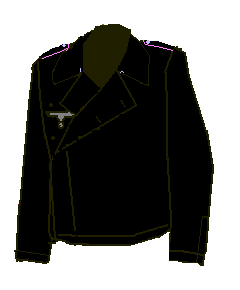| The Special Uniform for German Armoured Troops
The creation of the German Panzer arm brought
with it the need for a purpose built uniform for those men crewing the new array of
armoured fighting vehicles. The new uniform, known as Sonderbekleidung der
Deutschen Panzertruppen (Special Uniform for German Armoured Troops), is today
referred to universally by collectors as the "panzer uniform."
The AFV Jacket was introduced In November 1934, and made with
practicality in mind. Cut short in the waist, and with no external pockets, there
was a minimum of cloth that could get caught on the inner workings of a tank. Some
jackets had the shoulder straps sewn down for this reason as well. The jacket for
the "panzer uniform" was double breasted, for additional warmth, and made from
black wool; the dark colour helped conceal oil stains. The large collar had
Waffenfarbe piping, but NCOs did not wear their rank tress on the collar.
|
 |
|
| There was a deliberate attempt in
the German press from early on to associate modern tank troops with cavalry troops of old;
the black coloured uniform was linked to the 7th ("Black") Hussars of Frederick
the Great's army, and to later Prussian Leibhusaren and Brunswick Hussar regiments.
The death's head symbol used by ancient Hussar units was adopted as a collar patch for all
ranks wearing the new AFV uniform (see the page on AFV uniform collar insignia). First Pattern
The first pattern jackets are identified by the wide lapels,
described as "ornamental" in uniform references, they had no hook and eye to
secure the jacket closed, nor did they have buttons and buttonholes. The collar was
smaller than later jackets, and more "square" in shape.

The early pattern AFV Jacket showing the
wide lapels and piped collars.
| Second Pattern The second pattern of AFV uniform incorporated several key changes
beginning in 1936. Buttons and buttonholes were added so that the broad lapels could
be secured closed. A much more prominent gap was then found between the collar and
the lapel, and a metal hook and eye were added to secure the collar closed.
While the lapels were no longer as pointed as before, the
collar was enlarged and beame more pointed, ensuring the edge of the collar insignia would
no long sit flush with both edges of the collar.
 |
First and Second
Pattern collars. |
 |
|

Second Pattern Jacket, showing the hook
and eye placement as well as placement of buttons and buttonholes on the jacket and
lapels.
|
The collar of the first pattern
jacket is shown in the artist's painting at right, and illustrates nicely the fit of the
collar patch in relation to the collar edge piping. Below, Knight's Cross holder Walther
Böhm wears the second pattern AFV jacket; note the metal hook and eye just visible, and
also the way the collar patches no longer conform to the pink piping on the collar edge.
 |
 |
| Wartime Changes The original intention for the AFV uniform was that it only be worn
when the crewmen were in the vehicle; at all other times the standard Feldbluse was to be
worn. This restriction was ignored frequently, and espececially after the opening of
hostilities in 1939. The black AFV uniform was worn for parades and increasingly as
a walking out uniform despite official prohibitions. The garment was well liked and
thought of as especially handsome; it also brought readily to mind the lightning victories
of the early years of the war, for which the panzer troops were given much credit.
|
| In September 1939, new orders extended the range
of waffenfarben that might be encountered on AFV uniforms; the rapidly expanding number of
reconaissance units were granted the copper-brown waffenfarbe and armoured car and
halftrack crews were outfitted with the black AFV uniform. Signalmen serving in the
headquarters elements of panzer divisions were also permitted to wear the black AFV
uniform, with their distinctive lemon yellow waffenfarbe. |
|
|
 |
 |
| Since the double breasted design of
the jacket exposed the shirt, a mouse grey shirt and black necktie were introduced to be
worn with the uniform. Note the gap between lapel and collar on man at right, and
the metal hook and eye visible in the photograph. |
| In May 1940, Panzerpioniere - armoured engineers
- were ordered into the black AFV uniform, and in order to display their waffenfarbe they
adopted a black and white twist piping. This piping was only in use for a year;
armoured engineers changed over to the new field grey AFV uniform (see below). The design of the black AFV jacket did not change much further during
the war, though the waffenfarbe collar piping was discontinued in 1942. |
 |
|
| Reed Green AFV Uniform A uniform identical in cut to the panzer uniform, constructed of reed
green denim, was also introduced in May 1941; originally to armoured car crews only.
It was intended to be worn during the summer months in lieu of the heavy wool
uniform, and could also be used as an outer layer overtop of the black wool uniform in
winter.
In 1942, reed green jackets cut identically to the AFV
uniform began to be issued to tank crews also; these uniforms also had a large patch
pocket added to the left front chest. |

|














